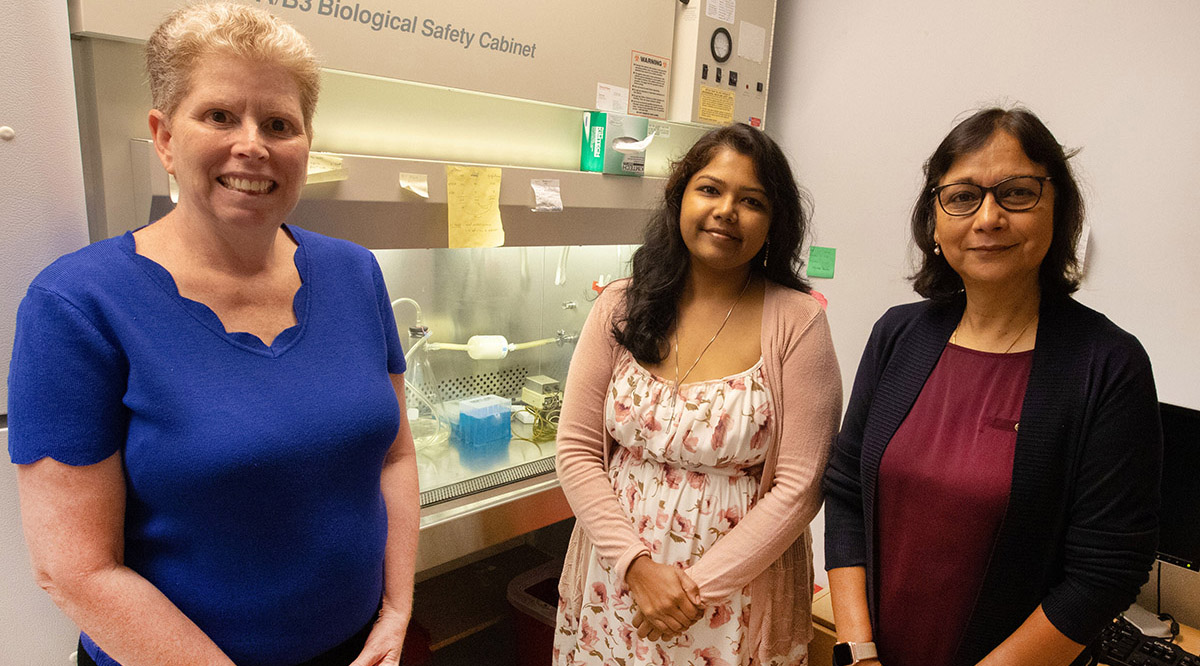Di-isononyl phthalate disrupts pregnancy in mice, study finds

From left, Jodi Flaws, Arpita Bhurke, and Indrani Bagchi are studying how di-isononyl phthalate affects the reproductive system of women. / Isaac Mitchell
We are constantly exposed to phthalates in our environment through plastic products such as storage containers, medical devices, packages, fabrics, and toys. Specifically, di-isononyl phthalate is inevitably becoming a part of our lives. Unfortunately, the impact of DiNP on the establishment and maintenance of pregnancy is largely unknown. In a new study, researchers used mice to understand how DiNP affects pregnancy.
“Although we finally recognize that environmental chemicals impact women's health, most studies have focused on men’s reproductive health and very few studies have looked at how these chemicals affect women,” said Jodi Flaws (EIRH co-leader/MME), a professor of comparative biosciences. “Our paper is novel because we are the first to look at this aspect of reproduction.”
For their study, the researchers chose a DiNP dose that humans are exposed to on a daily basis. They exposed pregnant female mice to DiNP orally for their first week of pregnancy, which is analogous to the first trimester in humans.
“I chose this window because most women don’t know from day one that they are pregnant. As a result, they maintain their general lifestyle for a while and may become more careful once they know that they are pregnant. During that time, however, they will continue to be exposed to DiNP,” said Arpita Bhurke, a postdoctoral fellow in the Bagchi lab and the first author of the paper.
In the early stages of pregnancy, the embryo attaches to the uterus and embeds in the maternal tissue, which supports the growth and development of the embryo. The process also stimulates the formation of new blood vessels, ensuring that the embryo has an adequate supply of oxygen and nutrients from the mother. Using tissue-staining techniques, the researchers found that DiNP exposure impairs the formation of blood vessels in both the maternal tissue and the placenta.
“In mice, these maternal blood vessels are formed after the first week of pregnancy and they have been exposed to DiNP before this development happens,” said Indrani Bagchi (EIRH co-leader), a Billie Field Professor of Reproductive Biology. “As a result, the tissue formation is effected and it creates a ripple effect, impairing embryo growth.”
The impact of DiNP on the placenta had several consequences later on in the pregnancy. The researchers found that pregnant mice that had been exposed to DiNP had smaller litter sizes and shorter gestation periods. Mice that were fed corn oil instead of DiNP produced an average of 16 pups per litter, whereas DiNP-fed mice produced 11 pups, and on average the pups weighed less. Additionally, instead of delivering their litter in 20 days, DiNP-fed mice were giving birth 18-24 hours earlier.
“We know that DiNP causes defects in the formation of the placenta. However, it is unclear whether this is due to the effect of DiNP on the embryo or on the maternal tissue or both. We want to address this question in our future work,” Bagchi said.
The researchers are also interested in deciphering how the chemicals impact the uterine tissue and litter birth. “I will focus on cell culture systems because we want to distinguish between the embryo and the maternal tissue effects. By using just the cells, we can better understand how DiNP is impacting the placenta in both early and late stages of pregnancy,” Bhurke said.
The study “Exposure to di-isononyl phthalate during early pregnancy disrupts decidual angiogenesis and placental development in mice” was published in Reproductive Toxicology and can be found at https://doi.org/10.1016/j.reprotox.2023.108446. The study was funded by the National Institutes of Health.
